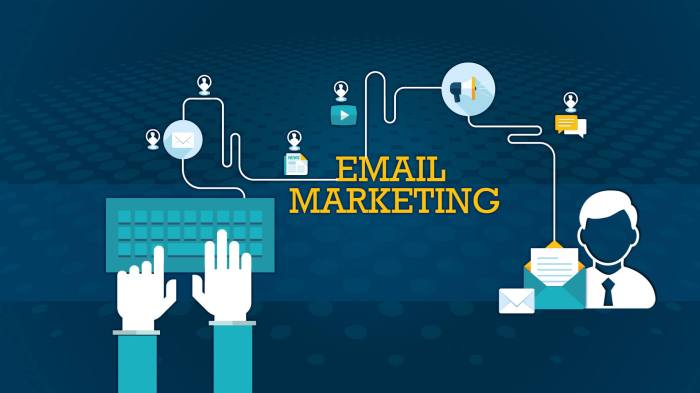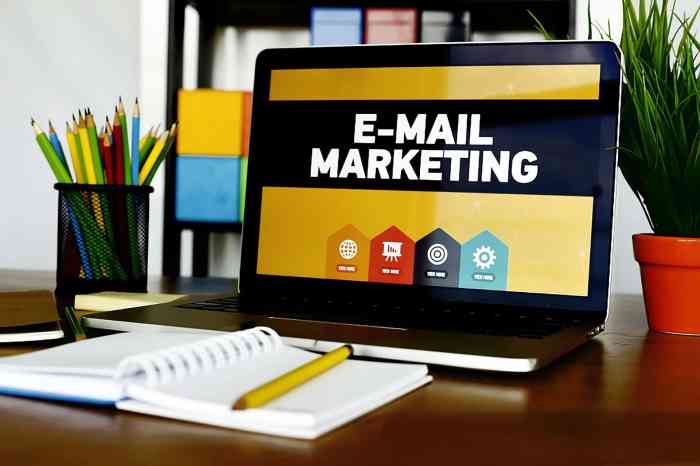Kicking off with Email Marketing Campaigns, this opening paragraph is designed to captivate and engage the readers, setting the tone american high school hip style that unfolds with each word. In today’s digital age, email marketing campaigns have become a crucial tool for businesses to connect with their audience and drive success. From personalized content to eye-catching designs, these campaigns play a vital role in engaging customers and boosting brand awareness.
Let’s dive into the world of Email Marketing Campaigns and explore the key elements that make them successful.
Importance of Email Marketing Campaigns

Yo, listen up! Email marketing campaigns are like the bread and butter for businesses these days. They are essential for reaching out to customers, promoting products, and building relationships. Let’s break it down for you.
Benefits of Email Marketing Campaigns
- Direct communication: With email campaigns, you can directly connect with your audience, delivering personalized messages straight to their inbox.
- Cost-effective: Compared to traditional marketing methods, email campaigns are super affordable and can generate a high return on investment.
- Build brand loyalty: By consistently engaging with your customers through emails, you can build brand loyalty and keep them coming back for more.
- Trackable results: You can easily track the performance of your email campaigns, analyzing open rates, click-through rates, and conversions to optimize your strategies.
Engaging with Customers Effectively
When it comes to engaging with customers, email campaigns are the way to go. You can tailor your messages to different segments of your audience, ensuring that each subscriber receives content that resonates with them. By providing valuable information, promotions, and updates, you can keep your customers engaged and interested in what you have to offer.
Elements of a Successful Email Marketing Campaign

To create a successful email marketing campaign, it is crucial to pay attention to certain key components that can make or break its effectiveness. From personalized content to compelling subject lines and clear call-to-action buttons, each element plays a vital role in engaging subscribers and driving conversions.
Importance of Personalized Content
Personalization is key in today’s digital landscape. By tailoring your email content to the specific needs and interests of your subscribers, you can significantly increase engagement and conversion rates. Whether it’s addressing the recipient by name, recommending products based on past purchases, or sending targeted promotions, personalized content shows that you value your subscribers and understand their preferences.
Yo, wanna boost your Insta game and get more likes and comments? Check out this dope article on Increasing Instagram Engagement for some valuable tips to level up your social media presence!
- Address recipients by name to create a sense of connection and familiarity.
- Segment your email list based on demographics, purchase history, or engagement levels to send targeted content.
- Use dynamic content to personalize emails based on subscriber behavior, such as browsing history or email interactions.
Significance of Subject Lines and Call-to-Action Buttons
Subject lines and call-to-action buttons are the first things that recipients see in an email, making them critical elements of a successful campaign. A compelling subject line can entice recipients to open the email, while a clear call-to-action button prompts them to take the desired action, whether it’s making a purchase, signing up for a webinar, or downloading a resource.
Yo, if you wanna step up your Instagram game and get more likes and comments, check out this dope article on Increasing Instagram Engagement. It’s got some killer tips to help you boost your social media presence and connect with your followers on a whole new level. Don’t sleep on this, fam!
- Create subject lines that are concise, engaging, and relevant to the content of the email.
- Avoid using spammy or misleading subject lines that can damage your sender reputation.
- Place clear and prominent call-to-action buttons that stand out and clearly convey the next step you want recipients to take.
Designing Effective Email Marketing Campaigns
When it comes to designing effective email marketing campaigns, the visual appeal of your email templates plays a crucial role in capturing the attention of your audience and driving engagement. Here are some tips for creating visually appealing email templates:
Tips for Designing Visually Appealing Email Templates
- Use eye-catching images and graphics to make your emails visually appealing and engaging.
- Choose a color scheme that aligns with your brand identity and conveys your message effectively.
- Keep your design clean and uncluttered to ensure easy readability and navigation for the recipients.
- Include a clear call-to-action (CTA) button that stands out and prompts the recipients to take the desired action.
Responsive design is another crucial factor to consider when designing email campaigns. With the increasing use of mobile devices for checking emails, it is essential to optimize your emails for different devices and screen sizes to ensure a seamless user experience.
Importance of Responsive Design for Email Campaigns
- Responsive design allows your email templates to adapt to various screen sizes, ensuring optimal viewing experience on both desktop and mobile devices.
- By implementing responsive design, you can improve the readability of your emails and increase the chances of recipients engaging with your content.
- Mobile responsiveness can lead to higher click-through rates and conversions as more people access emails on their smartphones and tablets.
To optimize emails for different devices and screen sizes, consider the following strategies:
Optimizing Emails for Different Devices and Screen Sizes
- Use a responsive email template that automatically adjusts the layout based on the screen size of the device.
- Test your emails on various devices and email clients to ensure they display correctly and are easy to read on different platforms.
- Avoid using large images or heavy graphics that may slow down the loading time on mobile devices.
- Optimize your email content for mobile viewing by keeping the text concise, using a single-column layout, and increasing font sizes for better readability.
Crafting Engaging Email Content
Creating compelling and relevant content in emails is crucial for grabbing the attention of your audience and driving engagement. One effective strategy is to personalize the content based on the recipient’s interests and preferences. This can be done by segmenting your email list and tailoring the message to each group.
Importance of Storytelling in Email Marketing Campaigns
Storytelling plays a key role in email marketing campaigns as it helps to create a connection with the audience on an emotional level. By incorporating storytelling elements into your emails, you can make your content more engaging and memorable. Share relatable anecdotes, case studies, or customer testimonials to draw in the reader and keep them interested.
- Use a narrative structure to take the reader on a journey.
- Focus on evoking emotions and creating a personal connection.
- Weave in storytelling elements such as characters, conflict, and resolution.
- Keep the story authentic and relevant to your brand and message.
Maintaining a Balance Between Promotional and Informative Content
Finding the right balance between promotional and informative content is essential to keep your audience engaged without coming across as too salesy. It’s important to provide value to your subscribers by offering useful information, tips, or resources, while also subtly promoting your products or services.
- Limit promotional content to avoid overwhelming the reader.
- Focus on educating and entertaining your audience in addition to promoting your offerings.
- Include a clear call-to-action that guides the reader on the next steps.
- Avoid using overly sales-oriented language and focus on building trust and credibility.
Analyzing Email Marketing Campaign Performance
When it comes to analyzing the performance of email marketing campaigns, there are several key metrics that you should track to determine the success of your efforts. By monitoring these metrics, you can gain valuable insights into what is working well and where there is room for improvement.
Key Metrics to Track, Email Marketing Campaigns
- Open Rate: This metric measures the percentage of recipients who open your email. A high open rate indicates that your subject line and sender name are compelling enough to entice people to click.
- Click-Through Rate (CTR): The CTR reflects the percentage of recipients who clicked on a link within your email. A high CTR signifies that your content is engaging and relevant to your audience.
- Conversion Rate: The conversion rate measures the percentage of recipients who completed a desired action after clicking on a link in your email, such as making a purchase or signing up for a webinar.
- Bounce Rate: The bounce rate indicates the percentage of emails that were not delivered to recipients’ inboxes. A high bounce rate could signal issues with your email list quality or sender reputation.
- Unsubscribe Rate: This metric measures the percentage of recipients who opted out of receiving further emails from your brand. A high unsubscribe rate may indicate that your content is not resonating with your audience.
Tools and Software for Measurement
- Google Analytics: This tool provides detailed insights into website traffic generated from email campaigns, allowing you to track conversions and other important metrics.
- Mailchimp: Mailchimp offers robust email marketing analytics, including open rates, CTRs, and audience engagement data to help you optimize your campaigns.
- HubSpot: HubSpot’s marketing automation platform includes email performance tracking features that allow you to measure the effectiveness of your campaigns and make data-driven decisions.
Using A/B Testing for Optimization
A/B testing, also known as split testing, involves sending two versions of an email to different segments of your audience to determine which performs better. By testing variables such as subject lines, call-to-action buttons, and email content, you can optimize your campaigns for maximum effectiveness. Analyzing the results of A/B tests can provide valuable insights into what resonates with your audience and help you refine your email marketing strategies for better performance.